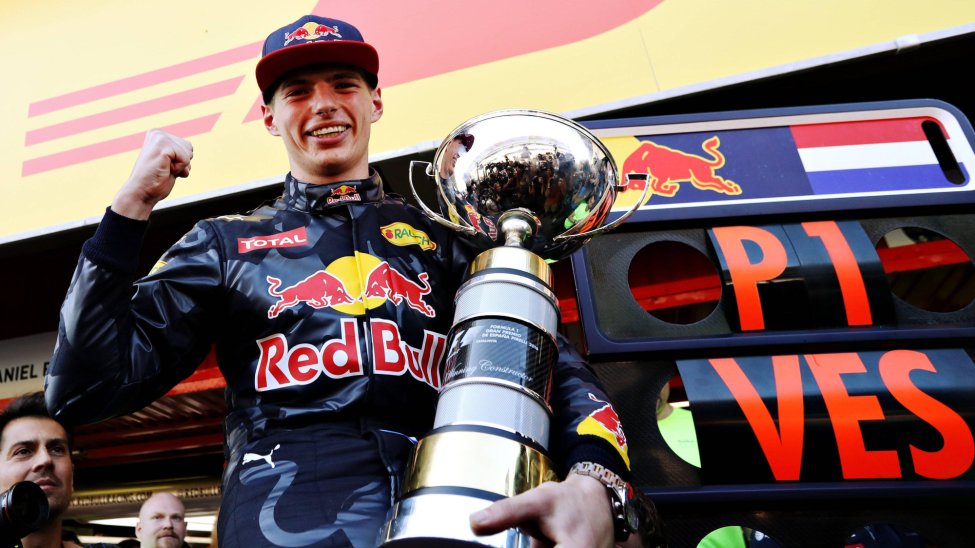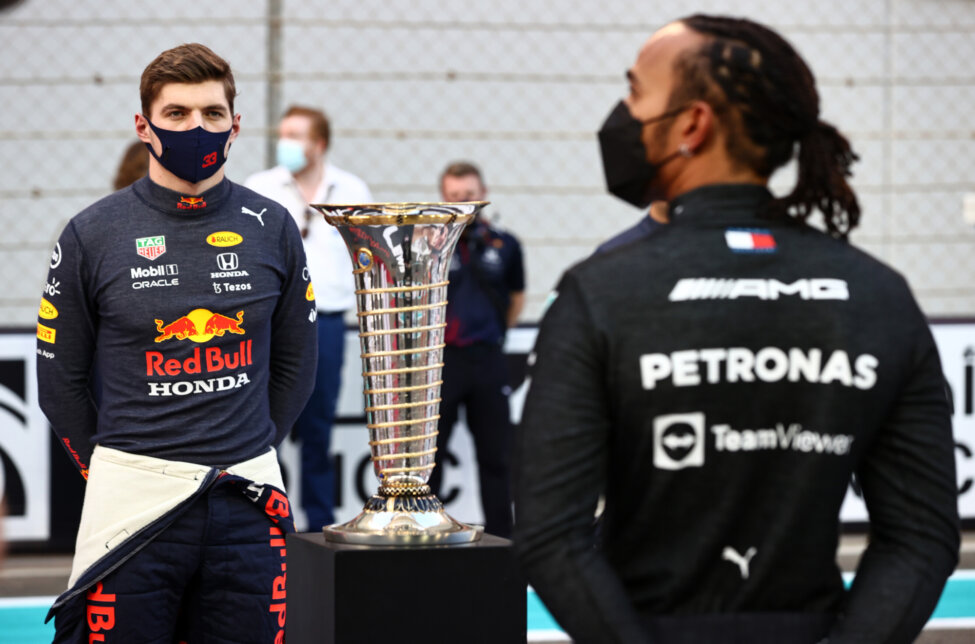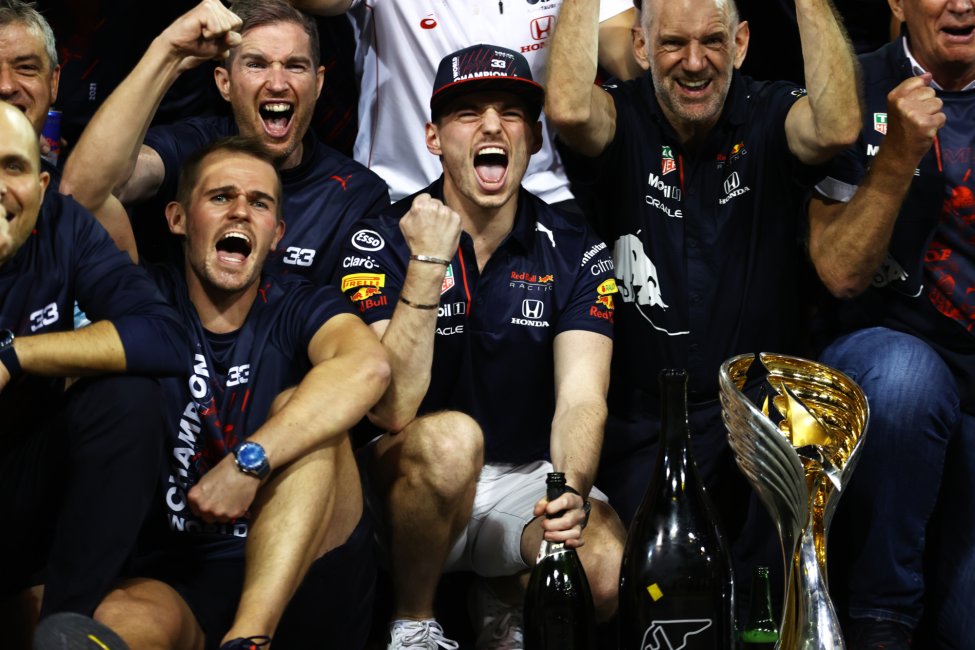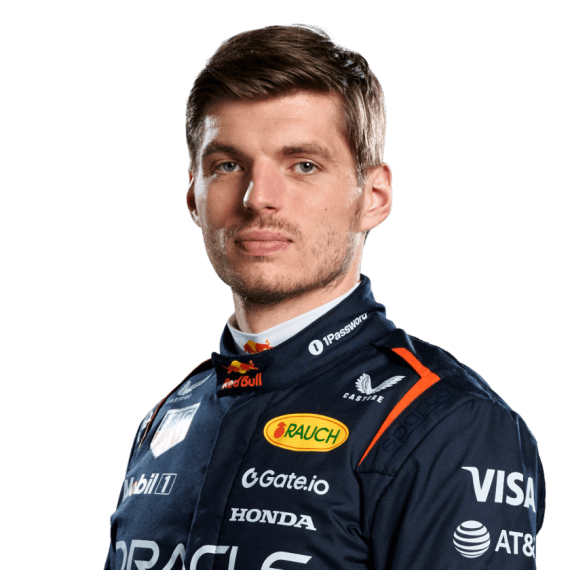

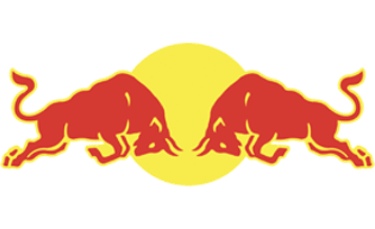
Red Bull Racing
Verstappen & LawsonMax Verstappen will defend his world title at Red Bull in 2025. After a disappointing performance by the team in the Constructors' Championship, the Austrian team hopes to improve this year with Liam Lawson as Verstappen's teammate.
Origins and Sauber sponsorship
Although Red Bull debuted in F1 as a team in 2005, their origins date back to the Stewart Grand Prix outfit that took to the grid in 1997.
Owner and three-time F1 World Champion Jackie Stewart sold the operation to Ford after two seasons, but the rebrand to Jaguar Racing yielded little success. As such, they were put up for sale in September 2004, with reports noting that Ford asked bidders for a symbolic $1 US fee, along with a commitment to invest $400 million into the team over three seasons.
Prior to the sale, Red Bull had been involved in F1 as one of Sauber's sponsors from 1995 to 2004. However, once Jaguar Racing were purchased, the long-term partnership was brought to an end.
F1 start with Cosworth engines
Christian Horner was named team boss of Red Bull's new F1 entry, with David Coulthard and Christian Klien selected as their first driver pairing. The initial plans called for Klien (retained from Jaguar) and 2004 International Formula 3000 champion Vitantonio Liuzzi to swap every four races, but come the end of the season the Italian had only appeared at four events.
Red Bull named their first chassis the RB1 and used Cosworth engines – a deal inherited from Jaguar. The car's best result was a fourth-place finish on debut in Australia, and a few months later at the Nurburgring, with both results achieved by Coulthard.
Compared to Jaguar's limited success, Red Bull were a massive hit in their first season. They found themselves holding sixth in the Constructors' standings for much of the season, only for BAR-Honda to overtake them later in the year.
By the end of the 2005 campaign, Red Bull finished with more points than Jaguar had scored in 2003 and 2004 combined.
Ferrari power and Newey signing
After just one year with Cosworth, Red Bull struck a deal that saw them use customer Ferrari engines in 2006. This move came following a rule change that mandated the use of V8 engines.
Perhaps more importantly, the team managed to secure the signing of Adrian Newey in November 2005. The British engineer was a key figure at Williams and later McLaren in the 1990s and 2000s, and would prove crucial in turning Red Bull into a dominant force in F1.
That success wasn't immediate, however, as Red Bull took a step back with the RB2 in 2006. Cooling and overheating issues plagued the car during early tests, and continued reliability problems in the first part of the season led to several retirements.
Nevertheless, Coulthard secured Red Bull's first podium with a third-place finish in Monaco. Horner had stated prior to the race that if one of his cars finished on the podium he would jump into a swimming pool at the track naked. He ended up taking the plunge wearing just a red cape.
Red Bull finished the season with 16 points, 18 fewer than their tally of 34 the previous year. Coulthard accounted for 14 of those points compared to Klien's two, with Robert Doornbos replacing the Austrian for the final three races.
2007 and 2008 season
The Newey-designed RB3 took to the grid in 2007, with Red Bull making the switch from Ferrari to Renault engines. The team's contract with the Scuderia was passed along to junior team Toro Rosso.
Red Bull's driver line-up was also changed, with Mark Webber brought in to race alongside Coulthard. Both drivers started the season slowly as they suffered eight retirements between them across the first seven races, though Coulthard did score the team's first points with a fifth-place finish in Spain.
A season highlight involved Webber claiming his second career podium at the unpredictable European GP, while Coulthard finished fifth despite starting back in 20th after the team kept him in the pits too long during qualifying.
Webber came close to victory at the Japanese GP but crashed with Toro Rosso youngster Sebastian Vettel, leaving the latter in tears. In the end, the team finished fifth in the Constructors' standings with 24 points.
The same driver line-up returned in 2008 with Webber scoring points in five straight races after retiring from the season-opener. Coulthard started at a slower pace but bounced back with a podium finish in Canada, helping Red Bull reach the same number of points they achieved in 2007 by the halfway point of the season.
However, from there, the team's form dipped, scoring just five points in the final 10 races. Their performance was made worse by the fact that Red Bull 'B team' Toro Rosso became the first Red Bull-owned outfit to win a race with Vettel's victory at the rain-hit Italian Grand Prix. The result helped Toro Rosso finish the season with more points – 39 to 29 – than Red Bull.
Vettel joins and Red Bull grow stronger
Coulthard retired at the end of the 2008 season with Red Bull promoting Vettel after a season with Toro Rosso.
The German showed he meant business immediately, running second during the Australian GP before retiring following a clash with Robert Kubica. Vettel scored Red Bull's first pole position at the Chinese GP, while Webber started third. The following day, in rain-soaked conditions, Red Bull took their first win thanks to Vettel, with Webber rounding out a 1-2 finish.
Vettel grabbed a second victory at the British GP after starting from pole, while Webber took his first win in Germany. Red Bull ended the year in style with a 1-2 finish at the Abu Dhabi GP; Vettel led the way and ended the year just 11 points adrift of World Champion Jenson Button. Red Bull also finished second in the Constructors' Championship, 18.5 points down on Brawn GP.
Vettel and Red Bull's breakthrough world titles
Both drivers returned for 2010 and Vettel wasted no time in taking pole at the opening round in Bahrain. He also looked to be on his way to victory, but slowed due to a spark plug failure and finished fourth. A front-row lockout in Australia saw Vettel retire while Webber could only finish ninth, though the team finally turned things around at the next race in Malaysia, as Vettel led home Webber in a 1-2.
Webber won back-to-back races in Spain and Monaco after starting both events from pole, taking the lead in the championship ahead of Vettel, though both drivers were locked together on 78 points.
Red Bull's run of seven straight poles was ended by Lewis Hamilton in Canada, but Vettel responded to win from the front in Valencia after leading every lap of the race. He started from pole at Silverstone as well, only for a bad start and puncture to scupper his efforts and limit him to seventh, while Webber won after leading the entire race.
Vettel's engine expired while leading the Korean GP with 10 laps remaining, handing the win and championship lead to Ferrari's Fernando Alonso. Nevertheless, Red Bull responded with a 1-2 finish in Brazil, led by Vettel, becoming the first Austrian team to win the Constructors' Championship in the process.
Although Vettel entered the final race of the season in Abu Dhabi third in the standings, behind Alonso and Webber, he snatched the Drivers' Championship by winning the race while his rivals finished outside the top six. All in all, Red Bull finished the year with nine wins (five by Vettel) and 15 pole positions (10 by Vettel).
Red Bull Racing's success continues
Red Bull continued with the Vettel-Webber pairing in 2011. Unlike the previous season, there was no surprise ending as Vettel cruised to his second championship.
Vettel became the ninth F1 driver to defend his world title, winning 11 of the 19 races, and claiming 15 pole positions to beat Nigel Mansell's record from 1992. Webber managed to take his only win of the season at the final race in Brazil, which helped him to finish third in the standings. Red Bull also added another Constructors' Championship to their trophy cabinet, finishing 153 points ahead of closest rivals McLaren.
Success continued in 2012 as Vettel took his third consecutive title, becoming the youngest triple World Champion. There were some bumps along the way, as Vettel's first win only came in Bahrain, four races into the season. In fact, he found himself trailing Alonso by 39 points after retiring from the Italian Grand Prix.
However, Vettel won four races on the bounce to assert his authority. Further podiums in Abu Dhabi and the United States put him in a strong position for the showdown in Brazil, where he needed some wiggle room following a first-lap collision with Bruno Senna. Having dropped to the back of the field, Vettel recovered to sixth place to secure the title by three points over Alonso, who came home second.
Red Bull fielded an unchanged line-up in 2013, with Vettel winning two of the opening four races. The first of those wins came amid some controversy in Malaysia. Running behind his teammate, Vettel disobeyed team orders and overtook Webber late in the race, much to the Australian's anger. Vettel subsequently apologised to the team, but not for winning.
After retiring at the British GP, Vettel won 10 of the final 11 races to secure the championship by 155 points over Alonso. His efforts saw him named 'Sportsman of the Year' at the Laureus World Sports Awards, becoming the second driver to receive that honour.
Vettel's win at the Italian GP was Red Bull's 40th, which came after he secured the team's 50th pole position. Red Bull also won their fourth consecutive Constructors' Championship, finishing 236 points ahead of Mercedes.
Webber retirement and Vettel departure
Webber announced that he would retire from F1 at the end of the 2013 season, with Red Bull promoting Daniel Ricciardo from Toro Rosso.
However, it was clear during pre-season testing that the Renault powered-teams would struggle in 2014 as they were down on power compared to Mercedes and Ferrari following the introduction of the new hybrid power units.
Red Bull managed to win three races and finish second in the standings, though they ended the year 296 points adrift of Mercedes. All the wins came via Ricciardo, who took the chequered flag for the first time in Canada.
The 2014 campaign proved to be Vettel's last with the team as he moved to Ferrari, with Daniil Kvyat replacing him. While Red Bull harboured hopes of closing the gap to Mercedes, thanks to the progress made by Renault, that wasn't the case as reliability and power issues plagued the team all season.
Red Bull ended the season without a win for the first time since 2008, as their best finish came in Hungary, where Ricciardo and Kvyat finished second and third. While the team tried to end their partnership with Renault, no deal was reached and, as a result, they ran Renault engines that were rebadged as TAG Heuer.
Improvement and emergence of Verstappen
Following the breakdown in relations with Renault, Red Bull ran Renault engines branded as TAG Heuer while also saying goodbye to Infiniti as their main sponsor.
Kvyat finished third at the Chinese GP behind Vettel and Nico Rosberg, but it wasn't enough to keep his seat as Red Bull opted to swap him with Toro Rosso's Max Verstappen. The move proved a stroke of genius as Verstappen won the Spanish GP on his debut for the team, becoming the youngest ever victor, podium finisher and driver to lead a lap at the age of 18 years and 228 days. Verstappen also became the first Dutch driver to take the chequered flag.
The team achieved several podium finishes while Ricciardo took his fourth career victory in Malaysia after an engine failure for Hamilton. Red Bull finished the season second in the Constructors' Championship, with Ricciardo third in the Drivers' Championship.
Both Verstappen and Ricciardo returned in 2017, but they started the season slowly with both drivers suffering retirements. Ricciardo took the chequered flag in Azerbaijan, while Verstappen slumped to three straight DNFs. Things improved for Verstappen later in the year as he took wins in Malaysia and Mexico, and finished second in Japan ahead of Ricciardo. At the end of the season, Ricciardo and Verstappen placed fifth and sixth in the standings respectively, while Red Bull slotted behind Mercedes and Ferrari in the Constructors' Championship.
Ricciardo and Verstappen clash
Although Red Bull suffered a double retirement at the second race of the 2018 season in Bahrain, the team answered back in China with Ricciardo taking victory after starting sixth. Unfortunately, another two DNFs followed in Azerbaijan as the teammates dramatically crashed into each other on the main straight.
Ricciardo took a second victory in Monaco after starting from pole; it was anything but straightforward, as an engine issue cost him power, though he managed to hold off Vettel's charge. It proved to be Ricciardo's final podium for the team as he departed for Renault at the end of the season.
Verstappen won Red Bull's home race in Austria, while Ricciardo was forced to retire with exhaust issues. Verstappen enjoyed a strong second half of the season, finishing on the podium six times from eight races. Meanwhile, Ricciardo suffered through several mechanical issues and retirements, with his best result being fourth on several occasions.
Verstappen and Ricciardo finished the year fourth and sixth respectively, while Red Bull once again wound up behind Mercedes and Ferrari. A major talking point throughout the season was the relationship between Red Bull and Renault, with the Milton Keynes-based outfit announcing by the French GP that they would be switching to Honda power following their impressive display for sister team Toro Rosso.
Moving to Honda engines
With Renault and Ricciardo gone, Honda and Pierre Gasly were brought in for the 2019 season.
The Frenchman failed to make much of an impression over the course of the opening 12 races, which stood in stark contrast to Verstappen, who won in Australia and Germany to go along with three other podium finishes. As a result, Red Bull opted to make a driver swap mid-season once again, promoting Alex Albon and sending Gasly back to Toro Rosso.
By the end of the year, Verstappen had finished on the podium another three times, and won in Brazil, to claim third in the standings, while Albon's best result was a fourth place in Japan, as Red Bull once again slotted behind Mercedes and Ferrari.
The 2020 campaign saw Red Bull climb to second in the Constructors' Championship. Verstappen won the 70th Anniversary GP at Silverstone to go along with a dominant display at the season-ending Abu Dhabi GP, while Albon recorded his first career podium at the Tuscan GP.
Albon would not stay at Red Bull for much longer than Gasly, however, having been outscored by Verstappen 214 points to 105 over the course of the season, prompting the team to look outside of their own talent pool and replace the Thai-British driver with Sergio Perez for 2021.
Red Bull vs Mercedes, Verstappen vs Hamilton
In 2021, new rear downforce regulations that appeared to hurt high-rake concept cars like the Mercedes – and solid improvements from the Red Bull-Honda camp – led to the first multi-team battle since the turbo-hybrid era began.
What followed was an explosive season as Red Bull and Mercedes, and Verstappen and Hamilton, went all out for title glory.
Verstappen enjoyed the stronger start, winning five of the opening nine races and opening up a 32-point buffer over his seven-time World Champion rival. However, the title race would soon take a turn as, after several close calls, the pair inevitably clashed.
The first flashpoint came at Silverstone where, as they squabbled for the lead on the opening lap of the Grand Prix, Verstappen and Hamilton banged wheels through Copse. The result was a terrifying trip to the barriers – and hospital – for Verstappen, following a 51G impact. It was later revealed by Horner that Verstappen had been briefly knocked out in the incident.
Despite being hit with a time penalty, Hamilton claimed victory on home soil and clawed back some of his deficit, which was cut further at the next round in Hungary – Hamilton's teammate, Valtteri Bottas, sparked an incident at Turn 1 which severely compromised Verstappen's race.
There would be further clashes at Monza (where Verstappen ended up on the top of Hamilton's car), Interlagos (where Verstappen defended aggressively in wheel-to-wheel combat) and Jeddah (where Verstappen was penalised for "erratic" braking when he was ordered to let Hamilton through after an illegal overtake).
Over the second half of the season, the battle ebbed and flowed as Red Bull proved quicker at some circuits, and Mercedes at others. Verstappen delivered a superb performance to claim victory as the Netherlands returned to the F1 calendar, while Hamilton enjoyed his own landmark moment in Russia by winning his 100th Grand Prix.
In the closing stages, the heated battle turned into war. Having questioned Red Bull's rear wing earlier in the year, Mercedes' own design, an apparent rear suspension 'trick' and a self-titled 'spicy engine' became hot topics, so much so that Horner described Hamilton as being in "another formula" in Brazil, where he twice fought through the field to take victory.
Hamilton's win at Interlagos was the first of three on the bounce, setting up the prospect of an incredible showdown in Abu Dhabi, with both title contenders locked on 369.5 points after 21 races. Essentially, it would be a head-to-head shootout for the crown.
Verstappen takes the title amid huge drama
Verstappen seized the initiative at the Yas Marina Circuit by storming to pole position, only to lose out to Hamilton at the start of the race. From there, Hamilton drove perfectly and appeared on course for a record-breaking eighth world title. However, in the most dramatic of circumstances, a late-race Safety Car – and questionable restart – turned the encounter on its head.
Verstappen took the opportunity to pit for fresh rubber under the Safety Car, while Hamilton stayed out on old Hards. When Race Director Michael Masi opted to clear the lapped cars between them out of the way and restart proceedings with a lap to go, the title was effectively decided. Hamilton could do nothing to prevent Verstappen from jumping ahead, and the young charger crossed the line to dethrone a despairing Hamilton.
More drama followed post-race as Mercedes lodged two protests, though these were thrown out by the stewards and the team ultimately opted against an appeal after the FIA announced that there would be a "detailed analysis" of events. Verstappen was therefore confirmed as the new World Champion and duly collected the Drivers' trophy at the FIA Prize-Giving Gala, which Hamilton and Mercedes boss Toto Wolff skipped.
Verstappen chose to use the number 1 one on his car in 2022, having taken up the option to swap out his otherwise permanent car number (33).
Red Bull Racing lead the pack in 2022 & 2023
A wave of new technical regulations were introduced into the sport for the 2022 F1 season, and it initially looked to be Ferrari who had the edge as the campaign got underway at the season-opening Bahrain Grand Prix.
It proved to be a nightmare event for Red Bull, with both Verstappen and Perez forced to retire due to mechanical issues. A victory followed for Verstappen one week later in Saudi Arabia, but he recorded another DNF at the following race in Australia.
While this had allowed Ferrari to take the momentum in the title battle, it wasn't long before Red Bull returned with a vengeance. Starting from the Emilia Romagna Grand Prix, the Milton Keynes-based outfit scored six race victories in a row, with five of these belonging to Verstappen.
Despite Carlos Sainz and Charles Leclerc taking wins in Great Britain and Austria respectively, Verstappen kicked off another winning streak at the French Grand Prix, claiming five P1 finishes in a row.
It was not long before Verstappen had built enough of a lead to clinch his second World Championship at the Japanese Grand Prix, while Red Bull secured the Constructors' title at the following race in the United States, marking their first team championship since 2013.
There was controversy away from the track when it was confirmed in October that the squad would be punished for breaching the 2021 cost cap. They were handed a $7 million fine, as well as having to forfeit 10% of their aerodynamic development allowance.
The team also hit the headlines at the penultimate race of the 2022 season in Brazil when Verstappen refused a team order to allow Perez to pass him on the final lap, claiming he had his reasons for doing so.
Perez later voiced his disappointment at his teammate's action, though both drivers went on to state that they had discussed the matter privately and that their relationship remained intact.
Verstappen rounded out the campaign with a win in Abu Dhabi, marking his record-breaking 15th victory of the season.
We thought this amazing record wouldn't be broken soon, but the 2023 season exceeded all our expectations. Max Verstappen won 19 of the 22 races within the season and got a podium in every race except the Singapore GP.
Max Verstappen broke many records and scored a monstrous amount of points, namely 575.
Red Bull struggles in 2024
At the start of the 2024 season, Red Bull looked strong again with Max Verstappen in first place and Sergio Perez in second. However, compared to the previous season, it was far from an easy year. The Red Bull's performance dropped, there was a lot of tension between Jos Verstappen and Christian Horner, and many prominent names left the Austrian team, such as Adrian Newey and Jonathan Wheatley.
The Constructors' Championship was lost, but the Drivers' Championship remained exciting with a battle between Lando Norris and Max Verstappen. Ultimately, this battle was fortunately won by the Dutchman for Red Bull. At the end of the season, the team decided to part ways with its teammate Sergio Perez due to disappointing performances. It was announced that Liam Lawson would replace the Mexican for the following season.
How will Red Bull perform with this new driver pairing in 2025?


